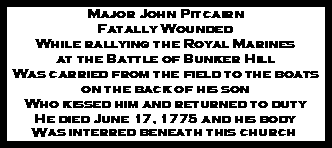



Major Pitcairn is buried in the Old North Church in Boston. There is a Pitcairn Plaque in the church remembering the soldier's heroism at the Battle of Bunker Hill.
The cenotaph reads:


Frank and Mary Collins visited the Old North Church, and sent this report:
The burial crypt of Major John Pitcairn is located in an area of the Old North Church which is not accessible to the general public. It is accessed at the front, left side of the church with steps down leading to the left. One then takes a right, passing the "new" area for current deaths, through a small portal (one must duck, step down and keep one's head low) and then you go left for approximately. 12 -15 feet -- take a right, and as one stands at the corner you are at the Majors crypt on your right side.
Photo by Frank and Mary CollinsMajor John Pitcairn lies in a crypt capable of holding about 12 - 15 caskets. We know this because we were able to view an unoccupied crypt. The crypt that contained Major John Pitcairn was of brick and mortar, as are the others. They were like cubicles with an entrance that was sealed on the front by mortar or by brick. The Major's was sealed by the mortar type substance. His headstone is a metal plate bolted into the frontplaque reading:

Photo by Frank and Mary CollinsThe crypt was on a corner so that the front and right sides were visible (as you look at it.)
There is a Coca-Cola machine directly across from the Major's crypt. I know it sounds crazy but it really was a Coca-Cola machine. Actually, there were two of them, side by side. For some reason I think the second one was a juice dispenser. I cannot explain what they were doing there. I do not recall that I heard a motor running so I do not think they were active. Nevertheless, it was a very strange sight considering where we were.
The subterranean area has a solid, concrete floor and the walls are brick in most of the supporting area and of piled stone and mortar in the others. As we reconstruct our trek down to the crypt area we realize that we are not under the church but to the left (as you look at the front of it).
In 1791, a coffin, said to be Major Pitcairn's was shipped to London for burial in the Church of St. Bartholomew the Less, in the vault belonging to his brother and son, the two Doctors Pitcairn. A highly dubious character (thief, fraudster and attempted bigamist - as well as former naval surgeon on the vessel Alliance) called Dr. Amos Windship (or Winship) was responsible for shipping the alleged remains back to London. Windship was in London ostensibly buying medical equipment, and befriended Dr. William Pitcairn and the Major's widow Elizabeth, promising to get the Major's remains sent over for them. He was not present at the Boston end of the transportation and may have deliberately duped the Major's widow and Dr. William Pitcairn...
The remains sent to London may have been those of a Lieutenant Shea - a work from the 1800's identifies the body as Shea, who died of inflammation of the brain, as there was a medical plaster on the head and no sign of wounds on the body. The Pitcairn family remained in ignorance of the mistake - Constance Pitcairn's 1905 book on the family was written in the belief that the real Major John Pitcairn lies in St. Bartholomew the Less in London. The mistake was known in America and The Old North Church maintains today that they still have the remains of Major Pitcairn.
Lt. Thomas Pitcairn, who bore his dying father from the Battle of Bunker Hill, transferred into the Infantry, eventually becoming Colonel of the 38th Regiment. He was married to Charlotte Proby, daughter of a naval officer. He died in 1797, aged 42, after a long illness, at his father-in-law Commissioner Proby's home at Chatham Dockyard.
William Pitcairn, who was also a Lieut. in the Marines at Bunker Hill, was promoted Captain, and died in 1779, aged 25 presumably of illness, as he's not referred to as killed. He was unmarried.
Major John Pitcairn's widow Elizabeth (Betty), later lived in Sloane Street, London. She was nearly 85 when she died in 1809, just a month or so after her eldest son Dr. David Pitcairn.


Ironically, the Old North Church's place in America's history derives from the night of April l8, 1775 when it's sexton, Robert Newman, climbed the steeple, and briefly hung the two lanterns which signalled the movement of Pitcairn's Marines to begin their march to Concord. The code arranged with the messengers was - "one if by land - two if by sea." William Dawes, Paul Revere's and Samuel Prescott's subsequent dash on horseback, brought out the militia that met Pitcairn at Lexington.

